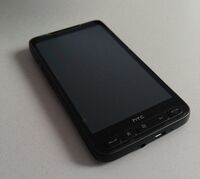HTC HD2 (htc-leo)
Appearance
| This device runs a Downstream kernel. Some UIs will not work, and most features (3D acceleration, audio, etc.) may be broken. |
 HTC HD2 | |
| Manufacturer | HTC |
|---|---|
| Name | HD 2 |
| Codename | htc-leo |
| Released | 2009 |
| Type | handset |
| Hardware | |
| Chipset | Qualcomm Snapdragon S1 (QSD8250) |
| CPU | 1.0 GHz Scorpion |
| GPU | Adreno 200 |
| Display | 480x800 |
| Storage | 512 MB / 1024 MB |
| Memory | 576 MB |
| Architecture | armv7 |
| Software | |
Original software The software and version the device was shipped with. |
Windows Mobile 6.5 Professional |
Extended version The most recent supported version from the manufacturer. |
Windows Mobile |
| postmarketOS | |
| Category | downstream |
Mainline Instead of a Linux kernel fork, it is possible to run (Close to) Mainline. |
no |
| Device package |
|
| Kernel package |
|
Flashing Whether it is possible to flash the device with pmbootstrap flasher. |
Works
|
|---|---|
USB Networking After connecting the device with USB to your PC, you can connect to it via telnet (initramfs) or SSH (booted system). |
Broken
|
Battery Whether charging and battery level reporting work. |
Works
|
Screen Whether the display works; ideally with sleep mode and brightness control. |
Works
|
Touchscreen |
Works
|
| Multimedia | |
3D Acceleration |
Broken
|
Audio Audio playback, microphone, headset and buttons. |
Untested
|
Camera |
Untested
|
| Connectivity | |
WiFi |
Works
|
Bluetooth |
Untested
|
GPS |
Untested
|
| Modem | |
Calls |
Untested
|
SMS |
Untested
|
Mobile data |
Untested
|
| Miscellaneous | |
FDE Full disk encryption and unlocking with unl0kr. |
Untested
|
| Sensors | |
Accelerometer Handles automatic screen rotation in many interfaces. |
Untested
|
| This device is a Windows Phone. See the Windows Mobile page for common tips, guides and troubleshooting steps |
Contributors
- Langoor
- (others on IRC)
- Dominduchami
- (others on the Matrix chat : Henri Dellal, knuxify and others)
What works
- Kernel boots
- Display and touchscreen works
- Boots with xfce and mate (UI's that require 3D acceleration are not working)
- Wifi works correctly
What does not work
- Usb networking
- 3D acceleration
- Everything else
Bootloaders
Because of the age of the HD2, there are serval 3rd party bootloaders available, most commonly used:
- Haret, Haret is a bootloader (provided as haret.exe) to boot linux or android from WITHIN windows mobile, you start windows mobile, not a great choice for postmarketOS.
- a(MagLDR), proprietary 3rd party bootloader developed by Cotulla and DFT, some folks over at Tytung's android forum, tried to reverse engineer it and created aMagLdr (1.13.04), unfortunately still proprietary
- cLK, based on littlekernel and download possible with cwm or twrp recovery embedded, seems to be the best option. Littlekernel also provides fastboot wich is handy. Only this bootloader is tested right now.
- An open source port of EDK2 is available here
Mainline Kernel
A close-to-mainline kernel port is available here with basic support for :
- screen via the EFI framebuffer
- interrupt controller
- timer
Installation
- Install HSPL
- Install the CLK bootloader
MAGLDR would probably also work, but using CLK is easier because of fastboot access.
- Install the rootfs using an SD Card
pmbootstrap install --sdcard=/dev/sd? - Insert the SD Card
- Boot the device into the CLK bootloader
- Flash the kernel to the boot partition using
pmbootstrap flasher flash_kernel(flashing to the additional partitions such as sboot or tboot should work too) - Select the first option (or the other boot partion if it was chosen in the previous step) to boot the kernel.
Flashing the rootfs and the kernel to NAND would probably work on the T-mobile US version of HD2 (it has 1gb of storage space), but it is untested for now.
Hardware
- USB: ci-hdrc-usb2
- Light sensor: Capella CM3602
- Wi-Fi: Broadcom BCM4329
- Magnetometer: Asahi Kasei AK8976A
- Battery charger: DS2746
How the wlan support was done
- Find what wlan chip is being used : bcm4329 in this case
- Read WiFi page
- Check what package contains firmware for the chip, in this case it is "firmware-aosp-broadcom-wlan"
- Change the firmware path in the kernel config
- Add a nonfree_firmware section :
nonfree_firmware() {
pkgdesc="Wifi firmware"
depends="firmware-aosp-broadcom-wlan"
mkdir "$subpkgdir"
}
- Update checksums, rebuild device and linux packages and boot the device
See also
- pmaports!1666 Merge request